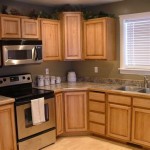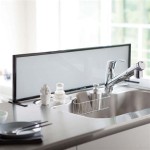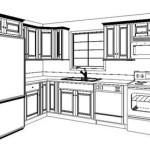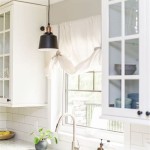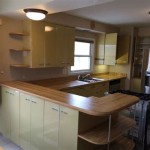Kitchen Island Bench Ideas With Seating Area and TV
The kitchen has evolved from a purely functional space into the heart of the home, serving as a hub for cooking, dining, socializing, and even entertainment. The kitchen island bench, particularly when integrated with a seating area and a television, exemplifies this transformation. A well-designed kitchen island can significantly enhance the usability and enjoyment of the kitchen, offering a versatile space for meal preparation, casual dining, and family interaction. The addition of a TV elevates the island from a practical work surface to a focal point for relaxation and entertainment, making it an ideal gathering spot for family and friends.
Designing a kitchen island bench with seating and a TV requires careful consideration of space, layout, and functionality. The size and shape of the island should be proportionate to the overall kitchen size, ensuring ample space for movement and comfortable seating. The placement of the TV needs to be strategically planned to optimize viewing angles and minimize glare. Furthermore, the design should seamlessly integrate with the existing kitchen style, creating a cohesive and aesthetically pleasing environment.
Optimizing Space and Layout
The dimensions of the kitchen island are critical for ensuring both functionality and comfort. A larger kitchen can accommodate a more expansive island, providing ample countertop space for food preparation and seating for multiple people. Conversely, in smaller kitchens, a compact island design is essential to avoid overcrowding the space. Consider the walkway space around the island; ideally, there should be at least 36 inches of clearance between the island and surrounding countertops or appliances to allow for easy movement.
The shape of the island also influences its functionality and appearance. A rectangular island is a classic choice, offering a generous work surface and ample seating along one or both sides. L-shaped islands can be particularly useful in maximizing corner space, while round or oval islands can create a softer, more social atmosphere. The shape should complement the overall layout of the kitchen, enhancing its flow and visual appeal.
Strategic placement of appliances and features within the island is paramount. If the island incorporates a sink or cooktop, ensure that there is sufficient countertop space around it for food preparation and cleanup. Consider adding storage solutions, such as drawers, cabinets, or open shelving, to maximize the island's functionality. The placement of the TV should be carefully considered, taking into account viewing angles and potential glare from windows or overhead lighting. Ideally, the TV should be positioned at a comfortable viewing height for those seated at the island.
The seating arrangement around the island should be designed to encourage interaction and conversation. Bar stools or counter-height chairs are a popular choice, providing comfortable seating at the island. Consider the style of the seating to complement the overall aesthetic of the kitchen. Backless stools can be tucked away neatly under the island when not in use, saving space. Alternatively, chairs with backs and armrests can provide added comfort for longer periods of sitting. The spacing between each seat should be sufficient to allow for comfortable movement and avoid crowding.
Integrating the TV Seamlessly
Incorporating a television into a kitchen island requires careful planning to ensure it is both functional and aesthetically pleasing. There are several options for mounting the TV, depending on the design of the island and the desired viewing angle. One common approach is to mount the TV on a swivel arm, allowing it to be adjusted for optimal viewing from different positions around the kitchen. This is particularly useful if the island is used for both food preparation and entertainment.
Another option is to build the TV into the island cabinetry. This creates a seamless and integrated look, concealing the TV when it is not in use. A lift mechanism can be used to raise and lower the TV from within the island, providing a clean and clutter-free appearance. Alternatively, the TV can be mounted within a recessed niche in the island, offering a more discreet and integrated solution.
Consider the size of the TV in relation to the size of the island and the viewing distance. A larger TV may be appropriate for a larger island, while a smaller TV may be more suitable for a more compact design. The viewing distance should be considered when determining the optimal screen size. A general rule of thumb is that the viewing distance should be approximately 1.5 to 2.5 times the diagonal screen size.
Concealing the wiring and cables associated with the TV is essential for maintaining a clean and organized look. Run the cables through the island cabinetry or walls to hide them from view. Consider using cable management systems to keep the cables organized and prevent tangling. Wireless connectivity options, such as Wi-Fi or Bluetooth, can also help to minimize the need for cables.
The acoustics of the kitchen should also be considered when integrating a TV. Hard surfaces, such as countertops and flooring, can reflect sound and create echo. Consider adding soft surfaces, such as rugs or curtains, to absorb sound and improve the listening experience. A soundbar or surround sound system can also enhance the audio quality of the TV.
Blending Style and Functionality
The design of the kitchen island should complement the overall style of the kitchen, creating a cohesive and harmonious environment. Consider the materials, colors, and finishes used throughout the kitchen when selecting the materials for the island. For example, if the kitchen features a modern aesthetic, a sleek and minimalist island with clean lines and stainless steel accents may be appropriate. Conversely, if the kitchen has a more traditional style, a wooden island with decorative details and a natural finish may be a better choice.
The countertop material is a key element of the island's design. Granite, quartz, and marble are popular choices, offering durability, aesthetic appeal, and a wide range of colors and patterns. Butcher block countertops can add warmth and character to the kitchen, while stainless steel countertops are a practical and hygienic option. The countertop material should be selected based on its durability, ease of maintenance, and aesthetic appeal.
The cabinetry of the island should provide ample storage space and complement the overall design of the kitchen. Consider incorporating drawers, cabinets, and open shelving to maximize the island's functionality. Drawers are ideal for storing utensils, cookware, and other small items, while cabinets can be used to store larger appliances and pantry items. Open shelving can be used to display decorative items or frequently used items, adding visual interest to the island.
Lighting is an important aspect of the island's design. Pendant lights can be hung above the island, providing task lighting for food preparation and ambient lighting for dining. Recessed lighting can be used to provide general illumination, while under-cabinet lighting can be used to illuminate the countertop. Consider using dimmable lighting to adjust the brightness and create a more relaxing atmosphere.
The seating area around the island should be comfortable and inviting. Choose bar stools or counter-height chairs that are ergonomically designed and provide adequate support. Consider adding cushions or upholstery for added comfort. The seating area should be sized appropriately for the number of people who will typically be using it. The spacing between each seat should be sufficient to allow for comfortable movement and avoid crowding. The placement of the seating should also not obstruct walking paths.
The overall design of the kitchen island should prioritize both style and functionality. The island should be aesthetically pleasing and complement the overall style of the kitchen, while also providing ample workspace, storage, and seating. Careful planning and attention to detail are essential for creating a kitchen island that is both beautiful and functional.
The kitchen island bench with seating and a TV is more than just a piece of furniture; it's an investment in the heart of the home. It transforms the kitchen into a multi-functional space where family and friends can gather, cook, dine, and be entertained. By carefully considering the space, layout, and design elements, one can create a kitchen island that is both beautiful and functional, enhancing the enjoyment and value of the home.
Ultimately, the best kitchen island design is one that is tailored to the specific needs and preferences of the homeowner. By taking the time to plan and design carefully, one can create a kitchen island that is both stylish and functional, enhancing the enjoyment and value of the home for years to come. A successful integration of these elements results in a kitchen that is not only a place to prepare food but also a central hub for family life and social gatherings.

7 Creative Design Ideas For Kitchen Island Bench Seating

7 Creative Design Ideas For Kitchen Island Bench Seating

7 Creative Design Ideas For Kitchen Island Bench Seating

7 Creative Design Ideas For Kitchen Island Bench Seating

Kitchen Island Table Ideas And Options Pictures

7 Creative Design Ideas For Kitchen Island Bench Seating

Kitchen Islands With Seating Pictures Ideas From

These Kitchen Islands With Bench Seating Beat Barstools Hunker

90 Modern Kitchen Island Ideas To Transform Your Home In 2025

30 Kitchen Islands With Seating And Dining Areas Digsdigs
Related Posts



